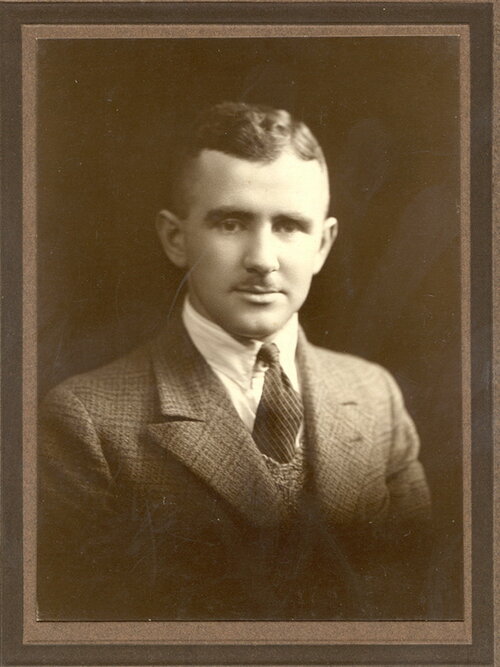- Joined
- 25 July 2007
- Messages
- 4,299
- Reaction score
- 4,196
This will probably be the shortest list ever - and they are names not actual designations!
Roger S. Dickson formed the Cloudcraft Glider Company of Osborne Road, Southampton in 1930 and it only lasted until the end of 1931. Dickson's primary purpose was to produce glider plans for sale to gliding clubs and individuals.
Cloudcraft Glider Company Design Names
Cloudcraft Dickson Primary - 1930 basic training glider [1]
- Dickson Primary: Zögling-type open-frame; Warren truss
- Dickson Primary: Span 10.45 m; airfoil Clark YH
- Dickson Primary: Intended for club constr. from plans
-- Dunning 'Lancia': Sailplane mod. of Dickson Primary
-- https://www.j2mcl-planeurs.net/dbj2mcl/planeurs-machines/planeur-fiche_0int.php?code=2725
-- http://claudel.dopp.free.fr/Les_planeurs/Descriptions_planeurs/Dickson-1930/Dickson-1930.htm
Cloudcraft Junior - (Project) 1931 single-seat sailplane
- Junior: Strut-braced, single-spar, stub-parasol wings
- Junior: Span 10.36 m; airfoil RAF 34 (modified)
- Junior: Constr. underway March 1931, never finished
-- Associated with the 1935 Penrose Pegasus sailplane [2]
-- https://www.j2mcl-planeurs.net/dbj2mcl/planeurs-machines/3vues/Cloudcraft_Junior_3v.jpg
Cloudcraft Phantom - 1931 single-seat high-perf. sailplane
- Phantom: Strut-braced, single-spar, stub-parasol wings
- Phantom: G158; span 15.54 m; airfoil RAF 34 (modified)
- Phantom: Long-span aerodyn. improved Junior deriv.*
-- Intended for cross-channel flight by owner Percy Michelson [3]
-- * Differed in span as well as rudder shape and cleaner nose
-- https://www.j2mcl-planeurs.net/dbj2mcl/planeurs-machines/planeur-fiche_0int.php?code=2729
___________________________________________________________________________
[1] There are no firm Dickson Primary construction numbers. Seven gliders were assigned British Gliding Association registery numbers. However, most Dickson Primary gilders were built from plans sold by Cloudcraft (and, later, by Flight magazine).
Wiki has an estimate of ~30 x Dickson Primary gliders built from ~100 x plans sold. I'm not sure if that includes the unlicensed production by the Nanchang Aircraft Manufacturing Corporation - or whatever that predecessor to the Central Nanchang Aircraft Manufacturing Factory was actually called.
[2] There has been the suggestion that Harald Penrose re-used partly complete wing panels from the unfinished Cloudcraft Junior. It's a nice story but highly dubious. For one, the airfoils are wrong - the Junior had a modified RAF 34 profile, the Pegasus a Göttingen 535-based profile. (There is also a difference in recorded span - 10.36 vs 10.47 m - although that may just be from rounding down the measurement for the Junior.)
[3] Michelson intended to fly cross-Channel to win the Cellon Prize - a £1,000 prize offered by the Kingston-on-Thames makers of Cellon dope. The Cellon Prize was for any flight of over 50 miles in a British-design and built sailplane (eventually won by R. G. Robertson who flew the Manuel Golden Wren the 52 miles from Derbyshire to York).
Percy Michelson's ventured ended when the Cloudcraft Phantom was vandalized by its "unruly" British Army guards/launch crew while on the cliffs of Dover while awaiting his flight. The remains of the sole Phantom ended up with Slingsby at Kirbymoorside but were never repaired or otherwise re-used.
-- https://www.j2mcl-planeurs.net/dbj2mcl/planeurs-machines/planeur-fiche_0int.php?code=2729
Roger S. Dickson formed the Cloudcraft Glider Company of Osborne Road, Southampton in 1930 and it only lasted until the end of 1931. Dickson's primary purpose was to produce glider plans for sale to gliding clubs and individuals.
Cloudcraft Glider Company Design Names
Cloudcraft Dickson Primary - 1930 basic training glider [1]
- Dickson Primary: Zögling-type open-frame; Warren truss
- Dickson Primary: Span 10.45 m; airfoil Clark YH
- Dickson Primary: Intended for club constr. from plans
-- Dunning 'Lancia': Sailplane mod. of Dickson Primary
-- https://www.j2mcl-planeurs.net/dbj2mcl/planeurs-machines/planeur-fiche_0int.php?code=2725
-- http://claudel.dopp.free.fr/Les_planeurs/Descriptions_planeurs/Dickson-1930/Dickson-1930.htm
Cloudcraft Junior - (Project) 1931 single-seat sailplane
- Junior: Strut-braced, single-spar, stub-parasol wings
- Junior: Span 10.36 m; airfoil RAF 34 (modified)
- Junior: Constr. underway March 1931, never finished
-- Associated with the 1935 Penrose Pegasus sailplane [2]
-- https://www.j2mcl-planeurs.net/dbj2mcl/planeurs-machines/3vues/Cloudcraft_Junior_3v.jpg
Cloudcraft Phantom - 1931 single-seat high-perf. sailplane
- Phantom: Strut-braced, single-spar, stub-parasol wings
- Phantom: G158; span 15.54 m; airfoil RAF 34 (modified)
- Phantom: Long-span aerodyn. improved Junior deriv.*
-- Intended for cross-channel flight by owner Percy Michelson [3]
-- * Differed in span as well as rudder shape and cleaner nose
-- https://www.j2mcl-planeurs.net/dbj2mcl/planeurs-machines/planeur-fiche_0int.php?code=2729
___________________________________________________________________________
[1] There are no firm Dickson Primary construction numbers. Seven gliders were assigned British Gliding Association registery numbers. However, most Dickson Primary gilders were built from plans sold by Cloudcraft (and, later, by Flight magazine).
Wiki has an estimate of ~30 x Dickson Primary gliders built from ~100 x plans sold. I'm not sure if that includes the unlicensed production by the Nanchang Aircraft Manufacturing Corporation - or whatever that predecessor to the Central Nanchang Aircraft Manufacturing Factory was actually called.
[2] There has been the suggestion that Harald Penrose re-used partly complete wing panels from the unfinished Cloudcraft Junior. It's a nice story but highly dubious. For one, the airfoils are wrong - the Junior had a modified RAF 34 profile, the Pegasus a Göttingen 535-based profile. (There is also a difference in recorded span - 10.36 vs 10.47 m - although that may just be from rounding down the measurement for the Junior.)
[3] Michelson intended to fly cross-Channel to win the Cellon Prize - a £1,000 prize offered by the Kingston-on-Thames makers of Cellon dope. The Cellon Prize was for any flight of over 50 miles in a British-design and built sailplane (eventually won by R. G. Robertson who flew the Manuel Golden Wren the 52 miles from Derbyshire to York).
Percy Michelson's ventured ended when the Cloudcraft Phantom was vandalized by its "unruly" British Army guards/launch crew while on the cliffs of Dover while awaiting his flight. The remains of the sole Phantom ended up with Slingsby at Kirbymoorside but were never repaired or otherwise re-used.
-- https://www.j2mcl-planeurs.net/dbj2mcl/planeurs-machines/planeur-fiche_0int.php?code=2729
Last edited:

